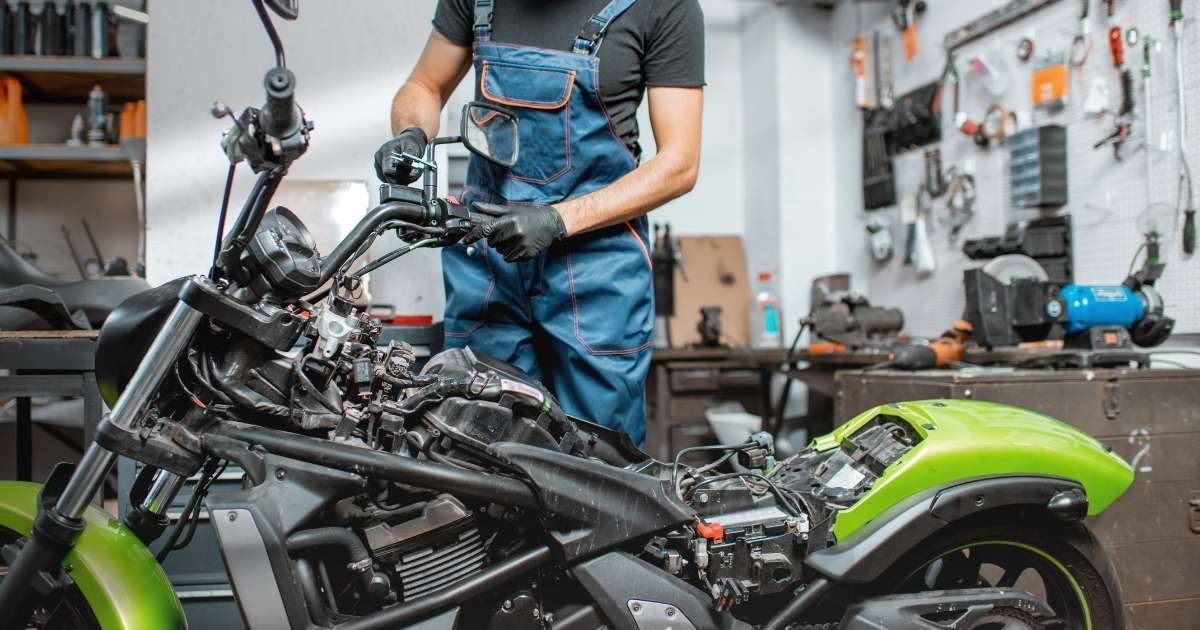Average Motorcycle Repair Costs
Did you know that regular motorcycle maintenance can extend your bike’s lifespan by up to 50%?
Taking care of your motorcycle isn’t just about ensuring a smooth ride—it’s also about keeping repair costs in check. Understanding the average costs of common repairs can help you budget better, avoid unwelcome surprises, and make sure you’re getting quality service when it’s time for a fix.
In this guide, we’ll break down the most common motorcycle repair costs and explore the factors that influence them. Whether you’re a new rider or a seasoned enthusiast, this information will empower you to make informed decisions and keep your bike running smoothly without breaking the bank.
Let’s get started!
Factors That Influence Motorcycle Repair Costs
Motorcycles, like any vehicle, require regular care to keep running smoothly, but the lingering question for many riders is: how much will repairs cost?

Whether you ride a cruiser, sportbike, or an older model, repair bills can vary widely depending on several key factors. Understanding these factors can help you avoid surprises and make informed decisions. Here’s a breakdown of what affects these costs and how to better prepare for them.
Type of Motorcycle
The type of motorcycle you own plays a big role in how much you’ll spend on repairs. It’s similar to maintaining a luxury car versus a regular sedan—certain brands, styles, and the complexity of your bike can affect repair costs. For example, cruisers, sportbikes, and touring motorcycles each have different maintenance needs. Premium brands like Harley-Davidson and Ducati are known for using high-end components, which means parts can be pricier. Plus, the specialized skills needed to service these bikes can add to the cost. It’s like caring for a rare pet—the more exotic it is, the more expensive and demanding it is to keep in good shape.
Age and Condition of the Bike
Older motorcycles can be like vintage treasures, but they come with their own set of challenges. As motorcycles age, parts can become harder to find, which drives up repair costs. If your bike hasn’t been properly maintained over the years, you’re looking at the potential for even pricier repairs, as worn components often lead to bigger issues. It’s similar to putting off a small home repair—delay long enough, and you could be looking at much larger, more expensive problems down the road. Regular maintenance is like putting money in a savings account for your motorcycle—you’re investing in its future and saving on repair costs in the long run.
Location and Labor Costs
Where you live also makes a big difference. Mechanics in urban areas generally charge more than those in rural regions, and you’ll likely pay a premium for specialized expertise in certain locales. Picture this: getting your bike serviced in a small-town shop might feel like chatting with an old friend, whereas visiting a high-end repair shop in the city can feel like checking into a five-star hotel—higher costs are built into the experience. And just as with any other service, the level of expertise you need can dictate the price. A seasoned mechanic who knows the ins and outs of your specific bike model will understandably charge more for their specialized knowledge.
Parts Availability and Quality
When it’s time to replace parts, you’ll often face the choice between Original Equipment Manufacturer (OEM) parts or aftermarket parts. OEM parts are produced by the same manufacturer as your motorcycle and are known for quality and compatibility—kind of like buying a custom-made suit. But, just as with tailored clothing, they come at a higher price. Aftermarket parts, on the other hand, can be cheaper but may lack the precision fit or longevity of OEM parts. It’s like choosing between a high-end, brand-name tool and a generic version—it might do the job, but there’s always the question of how well and how long.
Maintenance Frequency
Consistency is key when it comes to motorcycle maintenance. Riders who take the time to regularly service their bikes tend to face lower repair costs over time. It’s like going to the dentist for regular checkups—catching small problems early can prevent them from turning into costly disasters later. In contrast, neglecting basic upkeep can lead to more severe damage, requiring extensive and expensive repairs. Regular maintenance isn’t just an expense—it’s an investment that keeps your motorcycle running smoothly and helps you avoid those major, wallet-draining repairs that come from years of neglect.
By understanding these factors, you’ll be in a better position to anticipate repair costs and make informed decisions about maintaining your motorcycle without unnecessary surprises.
Common Motorcycle Repairs and Their Average Costs
Knowing the most common repairs and their associated costs can help you prepare for these expenses and keep your bike running smoothly. Let’s break down some key repairs and what you can expect to pay.
- Tire Repair
Average Cost: $200 – $500 (per tire, including installation)
Tires endure constant stress from road hazards, with common causes of damage including punctures from sharp objects, sidewall hits from curbs, and blowouts from improper inflation or overloading. These issues can lead to costly repairs and should be addressed quickly to prevent accidents or breakdowns.
Repair vs. Replacement Costs:
Minor puncture repairs (e.g., a nail in the tread) can often be fixed for around $20-$50, depending on the location of the damage and the repair shop’s rates. However, more serious damage, like a puncture in the sidewall, uneven tread wear, or cracks, will likely require a complete tire replacement, which costs between $200 and $500 per tire, including installation.
For damaged tires, it’s essential to replace them immediately to avoid the risk of a blowout or loss of control. Although regular tires generally last between 3,000 to 15,000 miles, depending on tire type, riding habits, and road conditions, severe damage should be addressed as soon as possible.
Brake Pad Replacement
Brake pads wear down naturally, but city riding, aggressive braking, and heavy loads accelerate this process. Frequent stops, hard braking, and extra weight strain the brake system, causing pads to deteriorate faster. Replacing worn pads is essential to ensure safety and avoid costly rotor damage. Squealing sounds, vibrations in the brake lever, and reduced braking performance are key signs of worn brake pads or damaged rotors, indicating the need for immediate replacement.
Repair Costs Breakdown
Fixing brake pads typically costs between $100 and $300, depending on your motorcycle type, brake pad brand, and local labor rates. High-end bikes, like sportbikes or touring motorcycles, can have higher costs due to specialized parts, with front brake pads often wearing out faster and costing more, as they handle most of the braking force.
Delaying brake pad replacement can lead to more expensive damage, such as scoring or warping the rotors, which can raise repair costs to $600 – $800 due to the need for rotor repair or replacement.
Chain and Sprocket Replacement
Average Cost: $150 – $300
The chain and sprocket play a key role in transferring power from your motorcycle’s engine to the rear wheel. Chains stretch and sprockets wear out with regular use, especially in high-speed or frequent riding. Without proper lubrication, chains can rust and cause uneven sprocket wear, while dirt and debris from riding in muddy or dusty conditions can speed up wear. Misalignment also adds stress, leading to damage. Lack of control, worn sprocket teeth, slipping or jerky movement, and strange noises like rattling or clunking are all signs that something chain and sprocket needs to be fixed. Proper maintenance is essential to avoid these issues.
Repair Costs Breakdown
Repairing or replacing the chain and sprockets generally costs between $150 and $300. The price varies depending on the type of motorcycle, quality of parts, and labor involved. Here’s a rough breakdown:
- Chain Repair/Replacement: Chains alone can cost anywhere from $50 to $150, depending on the material and brand. High-performance chains or those for larger bikes tend to be on the higher end.
- Sprocket Repair/Replacement: A sprocket set (front and rear) can range from $50 to $100.
- Labor Costs: The cost of labor is typically $50 to $100, depending on your mechanic’s rates. Installing a new chain and sprocket set requires precision and can be labor-intensive.
Delaying a chain or sprocket repair can result in dangerous riding conditions. A worn chain can snap, causing a sudden loss of power to the rear wheel or even damaging other components like the swingarm or engine case.
Battery Replacement
Average Cost: $100 – $250
Typically, batteries last about 3 to 5 years, but their ability to hold a charge weakens due to age, temperature, and usage habits. Corrosion on the terminals can lead to poor connections, making it harder to start your bike. Issues like electrical drain from leaving lights or accessories on can also wear down the battery, as can extreme temperatures—heat causes electrolyte to evaporate, while cold reduces battery efficiency. Common warning signs of a failing battery include slow engine cranks, dim lights, a swollen or leaking battery case, and frequent jump starts.
If you notice any of these symptoms, it’s probably time to repair or replace the battery to keep your motorcycle running reliably.
Repair Costs Breakdown
Battery repair costs can range from $100 to $250, depending on various factors. Here’s a breakdown of potential costs:
- Battery Replacement: A new motorcycle battery typically costs between $75 and $150. Premium or high-performance batteries can go higher, reaching $200 or more.
- Labor Costs: If you take your motorcycle to a mechanic, labor for battery replacement usually ranges from $25 to $100.
Delaying battery repair or replacement can leave you stranded and may strain the electrical system, potentially damaging other components.
Oil Change and Filter Replacement
Average Cost: $50 – $150
An oil change is one of the most important maintenance tasks for your motorcycle, ensuring that the engine runs smoothly and efficiently. While often categorized as maintenance, it can also be seen as a repair when considering the overall health of the engine.
Why Oil Changes Matter
Motorcycle engines depend on clean oil to lubricate parts, reduce friction, and manage heat. Over time, oil deteriorates and loses its ability to protect the engine, potentially leading to wear and expensive repairs. Contaminants like dirt, debris, and combustion byproducts can affect the oil’s performance, and neglecting regular oil changes can cause sludge buildup that damages the engine.
Additionally, oil leaks, often noticed as spots under the bike, need immediate attention to prevent further issues. Regular oil changes and addressing leaks are essential for maintaining engine health and performance.
Recommended Oil Change Frequency
For optimal performance, it’s generally recommended to change your oil every 3,000 to 5,000 miles or every 6 months, whichever comes first. Always refer to your owner’s manual for specific guidance based on your motorcycle model.
Repair Costs Breakdown
- Oil and Filter Cost: The oil typically costs between $30 and $70, while a new oil filter ranges from $10 to $20.
- Labor Costs: Mechanic labor can add $20 to $60 to the total cost, depending on the shop’s rates.
Skipping oil changes can cause serious engine problems and costly repairs. Regular oil changes boost engine life, performance, and fuel efficiency.
Engine Repair
Average Cost: $200 – $500
Engine repairs are often the most complex and expensive part of motorcycle maintenance, so understanding common issues and their costs can help you make better decisions.
Overheating is one common problem, usually caused by low coolant, a faulty water pump, or a blocked radiator, and it can lead to serious engine damage if not addressed.
Oil leaks, often due to worn gaskets or seals, can result in engine failure from lack of lubrication if ignored. Fuel system issues, such as clogged injectors or a failing fuel pump, can affect engine performance, with repairs ranging from injector cleaning to pump replacement.
Transmission problems, like issues with the clutch or gear system, can also impact engine efficiency and require attention. Staying ahead of these problems can help avoid expensive repairs down the road.
Typical Engine Repair Costs
- Minor Repairs: Issues like oil leaks or minor gasket replacements may cost between $200 and $500.
- Moderate Repairs: Problems with fuel injectors, ignition systems, or overheating repairs can range from $500 to $1,000.
- Major Repairs: Complete engine overhauls or replacements due to severe damage can cost $1,000 and up, with some repairs exceeding $2,500.
Regular maintenance helps prevent costly engine repairs by catching issues early, saving money, and extending your bike’s life. If you notice unusual noises, reduced performance, or warning lights, consult a mechanic immediately to avoid further damage and bigger repair bills later.
Clutch Repair/Replacement
Average Cost: $300 – $800
A faulty clutch can make shifting gears difficult and may even leave your bike undriveable. Worn clutch plates can cause slippage, and shifting difficulties, especially for aggressive riders or those in stop-and-go traffi,. Hydraulic issues, like leaky master or slave cylinders, can also disrupt clutch operation, while frayed or broken cables in cable-operated clutches can lead to failure. Additionally, oil contamination in the clutch assembly can also cause slippage or complete failure, requiring repair or replacement.
Typical Clutch Repair Costs
- Minor Repairs: Simple adjustments, cable replacements, or hydraulic repairs can cost between $300 and $500.
- Moderate Repairs: Replacing worn clutch plates or repairing hydraulic systems may range from $500 to $700.
- Major Repairs: Extensive work, such as complete clutch replacement or repairs involving the transmission, can cost $700 to $800 or more.
Ignoring clutch issues can lead to costly transmission damage. Stay on top of performance and address signs of wear or slippage early to save money and keep your motorcycle safe.
Electrical System Repair
Average Cost: $100 – $500
A malfunctioning electrical system can cause anything from dead lights to a complete bike failure, and understanding the common causes can help you address them more effectively. Faulty wiring, often due to vibrations, heat, or weather exposure, can lead to shorts or open circuits, creating various electrical problems. Dead batteries, especially in extreme weather, can prevent your bike from starting and may need replacing. Blown fuses, which protect the system from overloads, can knock out components like headlights or turn signals.
Additionally, malfunctioning lights, whether from burnt-out bulbs or wiring issues, can impact both your visibility and safety on the road.
Typical Electrical System Repair Costs
- Minor Repairs: Fixing simple issues like blown fuses or replacing bulbs can cost between $100 and $200.
- Moderate Repairs: Repairing or replacing wiring and connectors typically ranges from $200 to $400.
- Major Repairs: Extensive electrical system repairs, such as replacing the battery or major wiring harness work, can range from $400 to $500 or more.
Neglecting electrical issues can lead to a dead battery, leaving you stranded, or faulty wiring that poses fire risks. Early diagnosis and repair can prevent larger, costly problems and keep your bike running safely.
Tips for Reducing Motorcycle Repair Costs
Motorcycle repairs don’t have to drain your wallet. By following these simple tips, you can save money while keeping your bike in top shape:

- DIY Maintenance for Basic Repairs
Tasks like oil changes, chain lubrication, and checking tire pressure can be done at home, saving on mechanic fees. Invest in a basic tool kit and consult online tutorials or your bike’s manual. - Regular Maintenance
Prevent costly repairs by staying on top of routine checks like fluid levels and tire inspections. Keeping your bike in good condition now can prevent expensive breakdowns later. - Choosing Reliable Mechanics
Opt for certified mechanics with a good reputation. Quality service may cost more upfront but will save you from recurring issues caused by cheap repairs. - Using Aftermarket Parts
Aftermarket parts can be a cost-effective alternative for non-critical components like brake pads or mirrors, but always choose reputable brands to ensure quality. - Seasonal Discounts
Many shops offer promotions during the off-season or year-end sales. Timing your repairs during these periods can lead to significant savings.
By performing basic DIY tasks, maintaining your bike regularly, choosing a trusted mechanic, and taking advantage of seasonal deals, you can significantly reduce your motorcycle repair costs while ensuring your bike runs smoothly.
When to Repair vs. When to Replace Your Motorcycle
At some point, every rider faces a tough decision: is it worth repairing your motorcycle, or is it time to let it go and invest in a new one? Knowing when to repair and when to replace is important for both your wallet and peace of mind. Here’s a guide to help you make an informed decision.
- Assessing the Repair Costs vs. Value of the Bike
Before committing to repairs, assess whether they make financial sense based on your bike’s current value. If you’re looking at expensive repairs on an older motorcycle that’s depreciated significantly, it may not be worth the investment. For example, if the repair bill is $2,000 and your bike is only worth $3,000, upgrading might be a smarter choice, especially if the issues involve critical components like the engine or transmission. These repairs can be costly and could lead to further problems. It’s a good idea to get an estimate from a trusted mechanic and compare it to your bike’s market value using tools like Kelley Blue Book to determine if it’s worth saving.
- Consider the Long-Term Costs
Pay Now or Pay Later?
While repairing your bike may seem like the cheaper option initially, frequent and costly repairs can quickly add up. If you’re visiting the shop more often than you’d like, these expenses could soon surpass the cost of buying a new or slightly used motorcycle. For example, constant electrical or engine problems can lead to multiple mechanic visits, each costing several hundred dollars. Over time, this could equal what you’d invest in a newer, more reliable bike. Plus, newer models often offer improvements in fuel efficiency, safety, and technology, which can save you money in the long run. If your repair bills keep climbing year after year, it’s likely a sign that your bike’s best days are behind it.
Deciding whether to repair or replace your motorcycle comes down to evaluating both the cost of repairs and the long-term financial picture. If repairs exceed the value of your bike or you’re facing frequent mechanical issues, it might be time to consider moving on to a newer model.
How to Budget for Motorcycle Repairs
Motorcycle repairs can catch you off guard if you’re not financially prepared. The best way to avoid stress and keep your bike in top condition is by setting aside funds specifically for maintenance and unexpected repairs. With a little planning, you can ensure that no breakdown or wear-and-tear catches you off balance.
- Creating an Annual Maintenance Budget
Think Ahead!
Just like you budget for groceries, gas, or rent, your motorcycle requires regular upkeep to keep it running smoothly. Routine maintenance tasks—such as oil changes, tire replacements, and chain adjustments—are predictable expenses that should be included in your yearly budget.
To calculate how much to set aside, start by looking at your motorcycle’s maintenance schedule. Review the recommended service intervals in your owner’s manual and tally up the estimated costs. On average, you should plan for around $300 to $1,000 annually, depending on how often you ride, your bike’s condition, and the cost of parts and labor.
- Setting Up an Emergency Repair Fund
Motorcycles are prone to surprises—electrical failures, clutch problems, or blown gaskets are just a few examples of issues that can arise without warning. To avoid being blindsided by costly repairs, consider setting up a separate emergency fund. This fund is strictly for those unplanned breakdowns that require immediate attention, so you’re not dipping into your savings or daily budget.
On average, unexpected repairs can range from $200 to $2,000 depending on the severity of the issue. Having at least $500 to $1,500 saved specifically for emergencies will give you peace of mind, knowing that you’re prepared for whatever comes your way.
Conclusion
In conclusion, understanding the average motorcycle repair costs is important for any rider looking to maintain their bike’s performance and longevity without breaking the bank. Repairs like brake pad replacements, chain and sprocket fixes, and even engine work can vary widely in price depending on the make and model of the motorcycle, as well as labor rates in your area.
By staying informed about potential costs, budgeting for regular maintenance, and addressing minor issues before they escalate, you can save money and keep your bike running smoothly for years to come.







